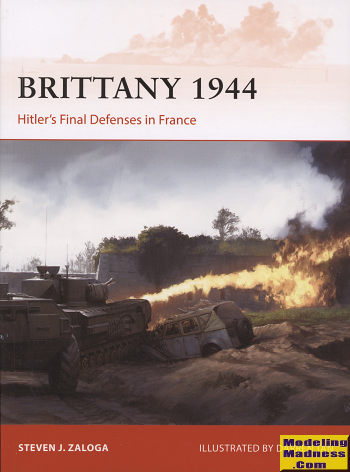 This
recent book in Osprey's well-received Campaign series covers a sector of WWII
that has not had very much written about it. Most of us are aware of Patton's
breakout of hedgerow country and his dash across northern France. However, there
was more to it than that. There was the campaign against the German-held French
ports, many of which were never overrun and only surrendered at the end of the
war.
This
recent book in Osprey's well-received Campaign series covers a sector of WWII
that has not had very much written about it. Most of us are aware of Patton's
breakout of hedgerow country and his dash across northern France. However, there
was more to it than that. There was the campaign against the German-held French
ports, many of which were never overrun and only surrendered at the end of the
war.
Initially it was felt that the Allies needed to liberate
the Atlantic coast ports in France in order to allow the free flow of supplies
to Allied armies in Europe. After all, if you don't have a good and somewhat
secure supply line, you are not going to win many battles. Warfare is as much
about logistics as it is weapons and troops.
However, the reality of the situation dawned on planners
when they saw how thoroughly destroyed the port of Cherbourg was. The effort to
clear the port and rebuild it enough to be useful again would take months, time
that they did not really want to spend as the war was moving at a fairly rapid
pace. So it was that the 'temporary' port at Normandy ended up playing a much
greater part. Indeed, using Normandy also meant that the actual supply line
would be shorter. This is generally a good thing.
So after changing their mind on the importance of
capturing the Brittany ports declined, the campaign in that part of France was
downgraded. Still, the movement of mostly US troops across Brittany was one of
the fastest movements of troops of the war. Much of this was thanks to several
things. One was that many of the good troops stationed there were sent to help
out in the Normandy campaign. The other is that the vast majority of those that
were left were either second-line types like Luftwaffe Flak and Naval gun crews
or were Russian eastern front volunteers. Not exactly the best.
However, the Germans had built substantial defensive
works and overlooking those that were facing the water to prevent sea landings,
were still considerable in nature. It was in this sector that the FFI or French
underground really played a major role. They kept the Germans in their redoubts
and helped to prevent the easy movement of patrols. They were also instrumental
in providing intelligence on what was up ahead.
This book concentrates on the rush across Brittany and
the eventual capture of the port of Brest and surrounds. After this campaign it
was felt that the rest of the port cities should simply be cut off. You get the
usual introduction on what occurred prior to the campaign and a look at the two
sides and their strategic goals. As usual, Osprey provides a great number of
period photos and you are provided with Darren Tan's excellent art work and maps
to help you keep track of what is going on. Another great read for the history
buff or those who are just interested in this area of operations. I learned a
lot from this one and I know you will as well. Get it while you can.
January 2019
Copyright ModelingMadness.com. All rights reserved.
For more on the complete line of Osprey books,
visit www.ospreypublishing.com .
If you would like your product reviewed fairly and quickly, please
contact
me or see other details in the
Note to
Contributors.
 This
recent book in Osprey's well-received Campaign series covers a sector of WWII
that has not had very much written about it. Most of us are aware of Patton's
breakout of hedgerow country and his dash across northern France. However, there
was more to it than that. There was the campaign against the German-held French
ports, many of which were never overrun and only surrendered at the end of the
war.
This
recent book in Osprey's well-received Campaign series covers a sector of WWII
that has not had very much written about it. Most of us are aware of Patton's
breakout of hedgerow country and his dash across northern France. However, there
was more to it than that. There was the campaign against the German-held French
ports, many of which were never overrun and only surrendered at the end of the
war.